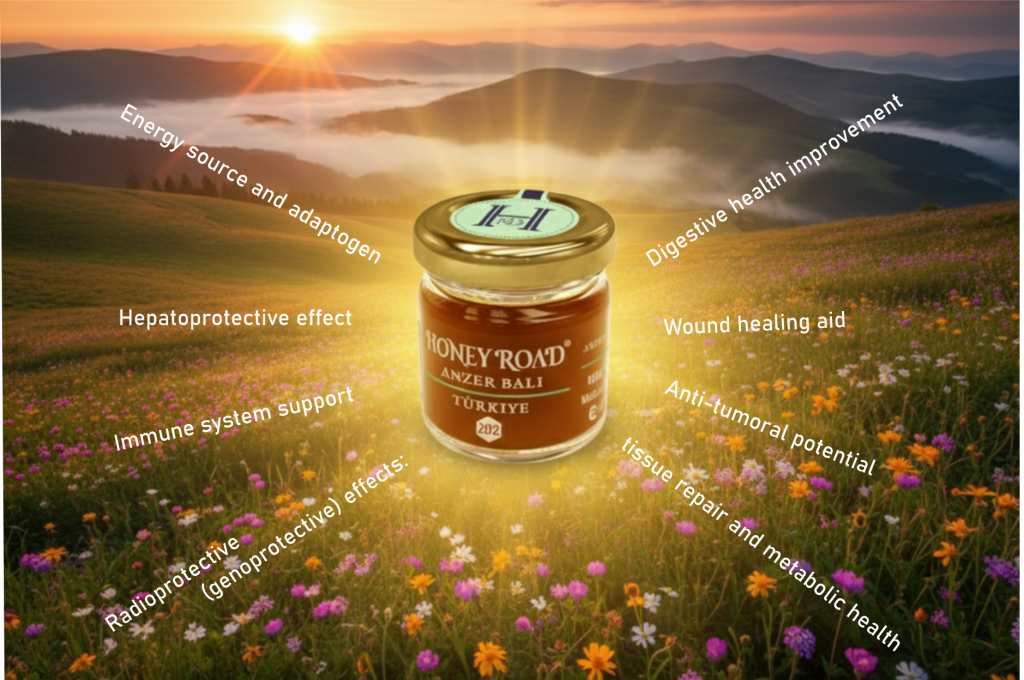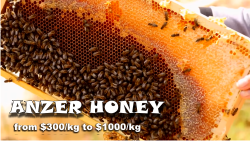Does Anzer honey have any therapeutic value? Are they only claims or scientific studies?
In this article, you’ll learn:
What “functional food” really means and why Anzer honey fits this definition.
What scientific studies say about the therapeutic properties of Anzer honey.
How its antioxidant activity compares to other honeys.
Which bacteria Anzer honey has been shown to act against thanks to its antimicrobial effects.
How it helps reduce inflammation and promote wound healing.
Why its unique mix of mountain flora gives it exceptional biological value.
How researchers classify Anzer honey among the world’s most powerful floral honeys.
Is Anzer honey a functional food? It is!
A functional food is not a supplement! It doesn’t come in the form of drugs, pills, or capsules like
nutritional supplements. It’s food believed to help prevent disease while meeting the body’s nutritional needs—something people choose for a healthier life.
“Functional foods” are similar to “nutraceuticals”, both widely used in the marketplace. Such foods are regulated by FDA (Food & Drug Administration) under the authority of the Federal Food, Drug, and Cosmetic Act, even though they are not explicitly defined by law.
Does Anzer honey have any therapeutic value?
It does. And this affirmation is supported not only by the folk claims, but also by scientific studies published in reputable journals and research platforms.
Anzer honey has powerful antioxidants, anti-inflammatory, anti-tumoral, antibacterial actions, and enzymes that promote digestive and immune health, with emerging evidence for radioprotective and hepatoprotective properties.

Anzer honey is a natural therapeutic food with a wide range of health benefits validated by scientific studies.
Based on the scientific studies, Anzer honey can be used to support the treatment or management of various health conditions, especially those involving inflammation, infection, oxidative stress, and tissue repair. Here is a list of diseases and conditions that may benefit from Anzer honey, according to the available research:
- Gastrointestinal disorders: Gastritis, peptic ulcers, irritable bowel syndrome (IBS), colitis, and other inflammatory digestive conditions.
- Wound and skin infections: Minor cuts, burns, ulcers, and other skin wounds due to its antibacterial and healing properties.
- Respiratory infections: Sore throat, cough, bronchitis, due to its soothing and antimicrobial effects.
- Immunocompromised conditions: Support in boosting immune response in cases of frequent infections.
- Inflammatory diseases: Arthritis, rheumatoid arthritis, and other systemic inflammatory conditions.
- Oral health issues: Gingivitis, periodontal disease, due to its anti-inflammatory and antimicrobial actions.
- Chronic inflammatory conditions: Conditions characterized by oxidative stress and inflammation, such as cardiovascular diseases.
- Healing after surgery or trauma: Tissue regeneration and reduction of inflammation facilitate recovery.
- Antioxidant support in degenerative diseases: Conditions involving oxidative damage, such as neurodegenerative diseases.
These applications are supported by studies demonstrating Anzer honey’s antioxidant, anti-inflammatory, antimicrobial, and tissue-healing properties.
But why does Anzer honey have such therapeutic power?
Because of its antioxidant, anti-inflamatory, antibiotic and so many other anti-something, that you can find briefly described here:
Anzer honey has strong antioxidant properties
The antioxidant capabilities are given by the phenolic compounds (gallic acid, caffeic acid, quercetin) and flavonoids. It actions by neutralizing free radicals and reducing oxidative stress that is linked to chronic diseases like heart disease, diabetes, and cancer.
There are more than 500 academic publications supporting the antioxidant power on Anzer honey. There are four main methods used to determine this capacity, based on honey’s ability to scavenge (neutralize) stable free radicals or reduce (donate electrons to) metal ions: DPPH Assay, ABTS Assay, FRAP Assay, Folin-Ciocalteu Method.
It is standard practice to use at least two different assays (e.g., DPPH and FRAP) along with the Folin-Ciocalteu method to get a comprehensive view of the honey’s antioxidant potential and to account for the different mechanisms by which various antioxidants work.
We learn from specialized literature (Ulusoy et al., 2010; Şahin et al., 2011; Malkoç et al., 2019) that Anzer honey shows high antioxidant activity compared to some flower honeys and low compared to dark-colored honeys such as chestnut.
According to Malkoç et al., phenolic substances found in Anzer Honey at the highest levels were pinocembrin, hesperidin, and chrysin.
Pinocembrin, detected at the highest concentration in Anzer honey, is an essential flavonoid with proven pharmacological activity in neurodegenerative and cardiovascular diseases. And it is well known that there is a positive correlation between total phenolic and total flavonoid content and antioxidant activity.
Antioxidant effect of Anzer honey is high among flower honeys
Among flower honey, Anzer has one of the highest antioxidant capacities. However, in chestnut honey this capacity is clearly higher (Saral 2018).
How can the antioxidant properties help the body?
Korkmaz & Kolonkaya showed in 2009, in an in vivo study with a control group, that Anzer honey is hepatoprotective against N-ethylmaleimide, a sulfhydryl blocker. And their conclusion was that this result might be due to the high antioxidant activity.
Anzer honey has proved antimicrobial activity
In regular honeys, the antimicrobial activity is given by its content of enzymes, like glucose oxidase that produces hydrogen peroxide, conferring antibacterial effects effective in healing wounds and preventing infections. In Anzer honey, the antimicrobial effect is attributed to polyphenolic compounds and other bioactive substances derived from the floral origin of Anzer honey.
The study „Antioxidant and Antimicrobial Activities of Selected Turkish Honeys”, conducted by Sevgi Kolaylı1, evaluated Anzer honey against eight bacteria and two fungi using the agar-well diffusion method. Anzer honey showed moderate antibacterial activity, especially against: Helicobacter pylori (strongest effect among all honeys tested), Staphylococcus aureus, Klebsiella pneumonia, and no activity against: Escherichia coli, Yersinia pseudotuberculosis, Pseudomonas aeruginosa, Bacillus cereus, the fungi Candida albicans and Candida tropicalis.
Conclusion of the study:
Anzer honey can be used in:
– treating gastric infections and ulcers – due to its pronounced effect on H. pylori
– wound healing and skin care, especially for infections caused by antibiotic-resistant strains – due to its activity against S. aureus.
Anti-inflammatory effects of Anzer Honey
Anzer honey’s anti-inflammatory properties are attributed to its rich flavonoids and phenolics that inhibit key inflammatory pathways and oxidative stress, its antimicrobial action that prevents infection-driven inflammation, and by promoting tissue regeneration with minimal side effects.
Anzer honey helps reduce inflammation in the body, beneficial for inflammatory digestive conditions such as gastritis and irritable bowel syndrome (IBS).
Additional scientific studies reinforce the anti-inflammatory effects of Anzer honey beyond its benefits for digestive conditions like gastritis and IBS.
- A review of honey flavonoids highlights how these compounds modulate inflammation by inhibiting pro-inflammatory enzymes (COX, LOX, iNOS) and mediators (cytokines, nitric oxide), with strong antioxidant activity that reduces oxidative stress driving inflammation. As Anzer honey has rich flavonoid content, this suggests a potent anti-inflammatory mechanism.
- Experimental studies show that honey reduces inflammatory parameters such as prostaglandins (PGE2, PGF2α) and tumor necrosis factor-alpha (TNF-α), enhancing tissue repair while diminishing edema and inflammatory cell infiltration. Honey also inhibits angiogenesis in inflamed tissues, without the side effects typical of corticosteroids or NSAIDs.
- Anzer honey contains antioxidant and bioactive compounds that protect cells from X-ray induced genotoxic damage, indirectly suppressing inflammatory responses triggered by oxidative stress.
So, is Anzer honey healthy and can it help us heal?
- Wound healing aid: Its antimicrobial and anti-inflammatory properties help treat minor cuts, burns, and scrapes by promoting tissue repair and preventing infection.
- Immune system support: Vitamins, minerals, and antioxidants boost the body’s natural defenses against infections like colds and flu, enhancing overall immunity.
- Digestive health improvement: Contains enzymes (diastase, invertase) that facilitate carbohydrate digestion, and prebiotic effects that promote beneficial gut microbiota, soothing the digestive tract and easing bloating and constipation.
- Hepatoprotective effect: Demonstrated protection of liver cells against toxic damage in vivo, likely due to antioxidant capacity.
- Radioprotective (genoprotective) effects: Shown in vitro to reduce DNA damage caused by X-ray radiation, indicating protective cellular effects against genotoxic stress.
- Anti-tumoral potential: Some studies suggest protective effects against cancer development linked to its antioxidant and phenolic profile.
- Supports tissue repair and metabolic health: Contains amino acids such as proline, lysine, and arginine important for protein synthesis, tissue regeneration, and immune function.
- Energy source and adaptogen: Traditionally used to boost energy and help adapt to high altitude conditions, reflecting its nutritional density and functional food qualities
In summary, Anzer honey combines powerful antioxidants, anti-inflammatory and antibacterial actions, and enzymes that promote digestive and immune health, with emerging evidence for radioprotective and hepatoprotective properties. This multifaceted profile presents it as a natural therapeutic food with a wide range of health benefits validated by scientific studies.
References:
- The effect of Anzer honey on X-ray induced genotoxicity in human lymphocytes: An in vitro study
- A Functional Food: Anzer Honey
- Antioxidant and Antimicrobial Activities of Selected Turkish Honeys
- https://livebeekeeping.com/honey/anzer-honey/
- In vitro anti-inflammatory properties of honey flavonoids: A review



